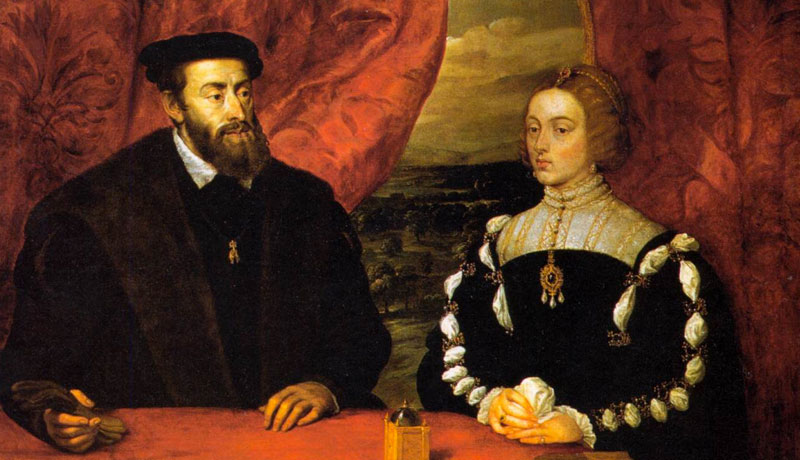For, in the wisdom of the Almighty’s ways,
He waits until the world shall be made one
Beneath an Emperor more just and wise
Than any who since Augustus shall arise.
A prince of Austrian and Spanish blood…—Ludovico Ariosto, (1532)
Imagine a young prince, born in 1500, who by age nineteen had inherited the Low Countries, Spain, Austria, half of Italy, some corners of France, bits of North Africa and exotic lands across the ocean in what was called the New World. He was also Holy Roman Emperor by election, and presided over a loose federation of German states and northern Italian duchies. History knows this prince by his imperial rank, Charles V, the just and wise Emperor prophesied in Ariosto’s epic poem about Charlemagne’s paladin Roland.
Charles reigned opposite extraordinary contemporaries: Francis I of France (1515-47), and Ottoman Turkish Sultan Suleiman the Magnificent (1520-66), with whom he was often at war; and Henry VIII of England (1509-47), an on and off ally. It was during Charles’s reign that Martin Luther’s Protestant Reformation spread and the Catholic Counter Reformation responded. Making Charles a world emperor, Hernán Cortés conquered Aztec Mexico, Francisco Pizarro, Inca Peru, and the Magellan expedition circumnavigated the globe. While involved with the flood of events, Charles, a prince of the Renaissance, actively supported great composers, patronized great artists such as Titian and Dürer, and built splendid palaces.
Friday March 31
Lecture Charles V of the Empire, Carlos I of Spain
Born in 1500 Charles had inherited by age 19 the Low Countries, Spain, Austria, half of Italy, some corners of France, bits of North Africa and exotic lands across the ocean in what was called the New World. He was also, by election, Holy Roman Emperor and presided over a loose federation of German States and northern Italian duchies. His richest inheritance was Spain, where he was known as Carlos I; it was comprised of the kingdoms of Aragon and Castile, as well as Castile’s growing overseas empire. Peter Pierson, (Professor Emeritus of History, Santa Clara University, and Professor at The Fromm Institute) will introduce us to Charles the man and will place him in the context of the tumultuous years in which he lived and reigned until his death in 1558, years central to the formation of the modern world.
Musical Performance
Secular Music from the sixteenth century will be presented by Shira Kammen and Friends.
Nicolas Gombert
Alleluya
Dezilde me al cavallero
Josquin Des Pres
Petite Camusette a 6
Johannes Ockeghem
Petite Camusette a 4
Thomas Crequillon
Petite Camusette a 7
Luis de Milan
Pavan # 6
Antoine Brumel
De tout plonget
Juan del Ensia
Si la Noche
Diego Ortiz
Recercada 2
Anon early 16th century Flemish
Adieu Mes Amours
Anon early 16th century Spanish/ Basque
Jançu Janto
Saturday April 1
Lecture Charles V and the Visual Arts
Charles V was the most far reaching collector of his age. The sheer variety of artistic production that he bought or commissioned has rarely, if ever, been surpassed. Not only was Charles the patron of Titian and Durer, but he also accumulated tapestries, coins, armor, and sculpture. Theodore Rabb,(Professor of History, Princeton University) will consider Charles’s artistic interests, his use of art as propaganda, and also the great palace that he planned for Granada. Through Charles’s eyes, we will gain a sense of the humanist and court culture that he embodied.
Lecture Imperial Vision and Overseas Empire
When Charles V assumed the imperial throne of the Holy Roman Empire in1519, he became part of a rich imperial tradition. In becoming king of the motley realms that formed early modern Spain, he also inherited a long and checkered tradition laden with ideological trappings and expectations.Teofilo Ruiz (Professor of History, UCLA) will seek to sort out these different imperial traditions with the emergence of Castile’s great New World Empire, which was signaled by the fall of Tenochtitlan in 1521, a few months after Charles was crowned Holy Roman Emperor at Aachen.
Musical Performance
Shira Kammen and Friends will perform sacred music of the Sixteenth Century including Josquin Desprez and contemporaries from the court of Charles V.
Josquin Des Pres
Ave Maria a 4
Mille Regretz
Christobal De Morales
Agnus Dei from Missa Mille Regrez
Isaac
La Spagna / Agnus Dei from Missa La Spagna
Anon
Maria Mater Gratie/ Fors Seulement from the Chanson of Marguerite of Austria
Ludwig Senfl
Ave Maria a 6
Lecture Charles V, Lord of the German Lands, and the Reformation of the Church Catholic
Thomas Brady (Professor of History, UC Berkeley) will discuss Charles’s rule of the German lands for thirty-seven years, a reign dominated by the religious question. The tumultuous eruption of dissent in the 1520s, the progress of Protestant resistance and collaboration from1529-1545, the first German religious war in 1546-1547, and Europe’s first religious peace in 1555 dominated the history of Charles’s imperial rule. By choosing to negotiate and arbitrate rather than use coercion, Charles helped to assure Germany would remain a country permanently divided in religion.
Lecture Charles V and Italy: The End of the Italian Renaissance?
Charles V played a crucial role in the rearrangement of power relations among Italian states. He ushered in a new period for Italian politics after his troops sacked Rome in 1527. Historians still differ in evaluating his impact on the political, religious, and even artistic life of the Italian peninsula.Elisabeth Gleason (Professor Emerita of History, University of San Francisco and Professor at the Fromm Institute) will examine some of these questions and connect them with attempts to reform the church, especially during the four decades From1520 to1550.
Panel Discussion
A conversation with the speakers from this program.
Presenters
Thomas Brady, UC Berkeley
Elisabeth Gleason, U of San Francisco
Shira Kammen, strings,
Peter Pierson, History, retired
Theodore Rabb, History, Princeton
Teofile Ruiz, History, UCLA
